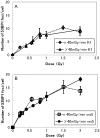Relative biological effects of neutron mixed-beam irradiation for boron neutron capture therapy on cell survival and DNA double-strand breaks in cultured mammalian cells
- PMID: 22966174
- PMCID: PMC3534280
- DOI: 10.1093/jrr/rrs079
Relative biological effects of neutron mixed-beam irradiation for boron neutron capture therapy on cell survival and DNA double-strand breaks in cultured mammalian cells
Abstract
Understanding the biological effects of neutron mixed-beam irradiation used for boron neutron capture therapy (BNCT) is important in order to improve the efficacy of the therapy and to reduce side effects. In the present study, cell viability and DNA double-strand breaks (DNA-DSBs) were examined in Chinese hamster ovary cells (CHO-K1) and their radiosensitive mutant cells (xrs5, Ku80-deficient), following neutron mixed-beam irradiation for BNCT. Cell viability was significantly impaired in the neutron irradiation groups compared to the reference gamma-ray irradiation group. The relative biological effectiveness for 10% cell survival was 3.3 and 1.2 for CHO-K1 and xrs5 cells, respectively. There were a similar number of 53BP1 foci, indicators of DNA-DSBs, in the neutron mixed-beam and the gamma-ray groups. In addition, the size of the foci did not differ between groups. However, neutron mixed-beam irradiation resulted in foci with different spatial distributions. The foci were more proximal to each other in the neutron mixed-beam groups than the gamma-ray irradiation groups. These findings suggest that neutron beams may induce another type of DNA damage, such as clustered DNA-DSBs, as has been indicated for other high-LET irradiation.
Figures





Similar articles
-
Molecular Mechanisms of Specific Cellular DNA Damage Response and Repair Induced by the Mixed Radiation Field During Boron Neutron Capture Therapy.Front Oncol. 2021 May 19;11:676575. doi: 10.3389/fonc.2021.676575. eCollection 2021. Front Oncol. 2021. PMID: 34094980 Free PMC article. Review.
-
Dose-rate effect was observed in T98G glioma cells following BNCT.Appl Radiat Isot. 2014 Jun;88:81-5. doi: 10.1016/j.apradiso.2013.11.117. Epub 2013 Dec 10. Appl Radiat Isot. 2014. PMID: 24360864
-
DNA double-strand break induction in Ku80-deficient CHO cells following boron neutron capture reaction.Radiat Oncol. 2011 Sep 5;6:106. doi: 10.1186/1748-717X-6-106. Radiat Oncol. 2011. PMID: 21888676 Free PMC article.
-
DNA Double-strand Breaks Induced byFractionated Neutron Beam Irradiation for Boron Neutron Capture Therapy.Anticancer Res. 2017 Apr;37(4):1681-1685. doi: 10.21873/anticanres.11499. Anticancer Res. 2017. PMID: 28373429
-
DNA damage and biological responses induced by Boron Neutron Capture Therapy (BNCT).Enzymes. 2022;51:65-78. doi: 10.1016/bs.enz.2022.08.005. Epub 2022 Sep 27. Enzymes. 2022. PMID: 36336409 Review.
Cited by
-
DNA Damage Response and Repair in Boron Neutron Capture Therapy.Genes (Basel). 2023 Jan 2;14(1):127. doi: 10.3390/genes14010127. Genes (Basel). 2023. PMID: 36672868 Free PMC article. Review.
-
Remarkable Boron Delivery Of iRGD-Modified Polymeric Nanoparticles For Boron Neutron Capture Therapy.Int J Nanomedicine. 2019 Oct 8;14:8161-8177. doi: 10.2147/IJN.S214224. eCollection 2019. Int J Nanomedicine. 2019. PMID: 31632025 Free PMC article.
-
Comparative study of the effects of different radiation qualities on normal human breast cells.Radiat Oncol. 2017 Sep 25;12(1):159. doi: 10.1186/s13014-017-0895-8. Radiat Oncol. 2017. PMID: 28946898 Free PMC article.
-
High-Accuracy Relative Biological Effectiveness Values Following Low-Dose Thermal Neutron Exposures Support Bimodal Quality Factor Response with Neutron Energy.Int J Mol Sci. 2022 Jan 14;23(2):878. doi: 10.3390/ijms23020878. Int J Mol Sci. 2022. PMID: 35055062 Free PMC article.
-
Molecular Mechanisms of Specific Cellular DNA Damage Response and Repair Induced by the Mixed Radiation Field During Boron Neutron Capture Therapy.Front Oncol. 2021 May 19;11:676575. doi: 10.3389/fonc.2021.676575. eCollection 2021. Front Oncol. 2021. PMID: 34094980 Free PMC article. Review.
References
-
- Bauchinger M, Koester L, Schmid E, et al. Chromosome aberrations in human lymphocytes induced by fission neutrons. Int J Radiat Biol. 1984;45:449–57. - PubMed
-
- Goodhead DT. Initial events in the cellular effects of ionizing radiations: clustered damage in DNA. Int J Radiat Biol. 1994;65:7–17. - PubMed
-
- Peak MJ, Wang L, Hill CK, et al. Comparison of repair of DNA double-strand breaks caused by neutron or gamma radiation in cultured human cells. Int J Radiat Biol. 1991;60:891–8. - PubMed
-
- Hendry JH, Potten CS, Merritt A. Apoptosis induced by high- and low-LET radiations. Radiat Environ Biophys. 1995;34:59–62. - PubMed
-
- Schmid E, Regulla D, Guldbakke S, et al. The effectiveness of monoenergetic neutrons at 565 keV in producing dicentric chromosomes in human lymphocytes at low doses. Radiat Res. 2000;154:307–12. - PubMed
Publication types
MeSH terms
LinkOut - more resources
Full Text Sources
Research Materials

